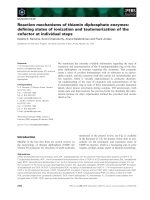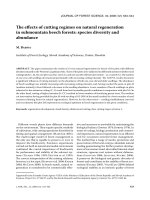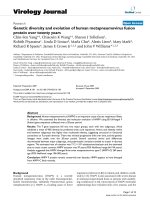Diversity And Abundance Of Spider Fauna Of Narmada River At Rajghat (Barwani) (Madhya Pradesh) India
Bạn đang xem bản rút gọn của tài liệu. Xem và tải ngay bản đầy đủ của tài liệu tại đây (315.1 KB, 5 trang )
Researcher, 2010;2(11)
/>
Diversity And Abundance Of Spider Fauna Of Narmada River At
Rajghat (Barwani) (Madhya Pradesh) India
*Shailendra Sharma, **Amrita Vyas, **Rekha Sharma
*Department of Zoology, Shri Umiya Girls College, Mandleshwar -451221 (M.P.) INDIA.
**Department of Zoology, Holkar Science College, Indore-452003 (M.P.) INDIA.
;
ABSTRACT: The Biodiversity of Narmada valley having rich biodiversity of spiders. The spiders of Narmada
valley were collected from Barwani from last week of August to Jan. 2010, using insect nets, tapping sticks,
umbrella. Pit fall trap etc. During this study 117 specimens were collected from the Rajghat (Barwani). 44 species
were identify belonging to 12 Families. Among the specimens most of the individuals were adult and few females
were observed the Family Araneidae represented 13 species, Salticidae represented 9 species, Oxyopidae 3,and
Eracidae 4 species, Theriddidae 3, and Thomosidae represented 2 species , Lycosidae 3 and Pholcidae represented 2
species. Families Clubionidae 1, Philodromide 1, Tetragnathidae 2, Uloboridae, represent 1 species. The population
of Spiders was abundant species richness and diversity was high during the month of October to December.
[Shailendra Sharma, Amrita Vyas, Rekha Sharma. Diversity And Abundance Of Spider Fauna Of Narmada
River At Rajghat (Barwani) (Madhya Pradesh) India. Researcher. 2010;2(11):1-5]. (ISSN: 1553-9865).
Keywords: Spiders, Biodiversity, Insect, Raighat, Narmada Valley
also eat many Insects that bothers humans, such as
mosquitoes and cockroaches. Since a single spider
may eat many mosquitoes in one day over the course
of its lifetime a spider may prevent hundreds of
mosquitoes from surviving to produce even more
mosquitoes offspring. Similarly a spider in your
house “pays rent” by ridding the premises of many
cockroaches or other insects.
Spiders are an important food source for
birds, lizards, wasps and other animals. Ground
dwelling spiders may be important in transferring
energy directly from the below-ground detritus food
wells to the above-grounds terrestrial food web of
familiar birds, reptiles, amphibians and mammals
(Johnston 2000) spiders are an important source of
food for many birds especially in the aeinter many
types of spiders construct specific types of silken web
to trap prey these come in a variety of forms, from
the familiar orb web and cobweb to sheets, funnels,
tabs, ladders and even a single thread. A single spider
may produce more than a half dozen difference kinds
of silk for difference purposes.
Spiders are clearly an integral part of global
biodiversity since the play many important role in
ecosystem as predators important role in food chain
of the ecosystem. They are one of the most common
predator group of ecosystem, they are hunters of
insects and other small invertebrates and reduced pest
animals inside and outside our houses they are prey
for many hunting animals like insectivorous birds and
reptiles most spider spend their entire life in one
particular habitat because of their ability to produce
silk. Venom and their use of defense macaronis.
1. Introduction
Biodiversity short for biological diversity
refers to all the population species and communities
in a defined area present study was designed to asses
the biodiversity valley is having very rich
biodiversity of spiders Narmada river hemmed
between Vindhya and Satpuda ranges extends over
area of 98, 796 km2, and lies between east longitudes
70o 32’ to 81o 45’ and north latitudes 21o 20’ to
23o 45’ lying in the northern extremity of the Deccan
plateau, the basin covers larges areas in the state of
Madhya Pradesh and Gujarat and a comparatively
smaller are in Maharashtra. There are 41 tributaries
out of which 22 are in the Vindhya ranges. Spiders
are arthropods called arachnids. They belong to order
Araneae is a large group of animals which is
commonly called as spiders. Spiders occupy an
important part of the overall predatory arthropod
fauna in different terrestrial ecosystem. All spider are
predators and because the man item in most spider
diets is insects human benefit enormously from
spiders are important in controlling insect pests in
most agricultural crops Bioindicators, spiders are the
largest groups of arachnids comprising more than
30,000 species distributed over 60 families world
wide. Spiders are carnivorous creatures feeding on
insects and small arachnids which is most abundant
and ecologically important in almost every terrestrial
and semi terrestrial habitat. On earth from cold tundra
and alpine ecosystem to tropical rain forests and
deserts. Some species live on the shorts of the ocean
and some live into ponds and streams in search of
prey members of one Eurasian spider family spiders
1
Researcher, 2010;2(11)
/>
About 34,000 species of spiders known to
science belong to about 105 families, about 10% of
these species are known from America, North of
Mexico (3,500 species, Roth 1933, Schaefer and
Kosztarab 1991). Many spider species are not yet
known to science, though particularly in the tropics.
Some arachnologists estimate that only 20% of spider
species have been described, meaning that there may
be as many as 1,70,000 spider species sharing our
planet with us (Coddington and Levi, 1991).
Some of the most diverse spider families
include the familiar hairy, big-eyed “Jumping
spiders” (family Salticidae 4,400 species worldwide);
the small “Sheet-web spiders” (Linyphiidae, 3,700
species); the “Orb weaving spiders” (Araneidae,
2,600 species); the “Cobweb spiders” (Theridiidae,
2,200 species); the non-web weaving “Wolf spiders”
(Lycosidae, 2,200 species); and the “Crab Spiders”
(Thomisidae, 2,000 species Coddington and Levi,
1991).
Tetragnathidae 2, Uloboridae, represent 1 species.
The population of Spiders was abundant species
richness and diversity was high during the month of
October to December.
1. FAMILY- ARANEIDAE
Araneus sp.
Araneus sp.
Araneus mitifica
Argiope sp.
Argiope aemula
Cyclosa hexatuberculata
Cyclosa spirifera
Cyclosa moonduensis
Cyclosa sp.
Neoscona theis
Neoscona sp.
Larinia sp.
Zygilla sp.
2. Materials and methods
Collection: spider fauna was collected from
forest plantation, crops, and agriculture fields and
wild plants in some habitats of Rajghat( Barwani).
Following methods are used for the
collection of spider. Spiders were collected from
Rajghat (Barwani) near Narmada valley for
collection of spiders insects nets pitfall trap stroking
sticks umbrellas were used the specimens were but in
to 70% alcohol, labeled and identified according to
Tikader (1962, 1973 1982). Before preservation the
photographs were taken in different views to get the
clear eye position pattern and shades of
cephalothoraxes and abdomen, hair and spines
pattern etc.
Identification: Identification was done on
the basis of morphometric characters of various body
parts.They help was mainly taken from the keys and
catalogues provided by,Kaston (1978), Tikader and
Biswas (1981),Tikader(1982),Davies and Zabka
(1989),Plantnick
(1989),Biswas
and
Biswas
(1992),Barrion and Litsinger (1995),Gajbe (1987),
Nentwig et al.(2003)and Platnick (2004)
3. Result and dissution
During this study 117 specimens were
collected from the Rajghat(Barwani). 44 species were
identify belonging to 12 Families. Among the
specimens most of the individuals were adult and few
females were observed the Family Araneidae
represented 13 species, Salticidae represented 9
species, Oxyopidae 3,and Eracidae 4 species,
Theriddidae 3, and Thomosidae represented 2 species
, Lycosidae 3 and Pholcidae represented 2 species.
Families
Clubionidae
1,
Philodromide
1,
2. FAMILY-CLUBIONIDAE
Clubiona sp.
3. FAMILY-ERASIDAE
Stegodypus sp.
2
Researcher, 2010;2(11)
/>
Stegodypus sp.
Stegodypus prakashi
Stegodypus sarasinorum
4. FAMILY-LYCOSIDAE (WOLF SPIDERS)
Lycosa sp.
Hyppasa sp.
Hyppasa sp.
5. FAMILY-OXYOPIDAE (LYNX SPIDERS)
Oxyopus pankaji.
Oxyopupus
Oxyopus sp.
6. FAMILY-PHILODROMIDAE
Philodromous sp.
Thiania sp.
Telamonia sp.
Euophrys sp.
Phidippus sp.
Plexipus sp.
9. FAMILY –TETRAGNATHIDAE (LONG)
Tetragnatha mandibulata
Tetragnatha sp.
10. FAMILY-THERIDIDAE
Theridion sp.
Leucauge decorate
Leucauge sp.
11. FAMILY-THOMISIDAE (CRAB SPIDERS)
Thomisus sp.
Xysticus sp.
12. FAMILY-ULOBORIDAE
Uloborus sp.
7. FAMILY-PHOLCIDAE
Pholcus sp.
Pholcus sp.
8. FAMILY-SALTICIDAE
Myrmarachne sp.
Phintella sp.
Marpissa sp.
Thyene sp.
Spider Diversity
3
Researcher, 2010;2(11)
/>
more complex shrubs can support a more diverse
spider community. Downie et al.(1999) and New
(1999) have demonstrated that spiders are extremely
sensitive to small changes in the habitat structure,
including habitats complexity, litter depth and
microclimate characteristics. Spiders generally have
humidity and temperature preferences that limit them
to areas within the range of their “physiological
tolerances” which make them ideal candidates for
land conservation studies (Riechert, Gillespie
1986).therefore, documenting spider diversity
patterns in this ecosystems can provide important
information to justify the conservation of this
ecosystem.
This is the first attempt in the central part of
Madhya Pradesh. Spider Fauna were studied during
the present study. No body has done work on such
aspects .During the present investigation 44 species
Identify out of 117 specimens were collected.
This study shows that the Narmada River
basin has rich Biodiversity of Spiders Fauna.
1) Dr. Shailendra Sharma
(Corresponding Author)
Principal.
Shri Umiya Girls College, Mandleshwar-451221
(M.P.) India.
Email:
The spiders were found to be living in
different types of habitats the spiders belonging to
Families Araneidae, Tetragnathidae, Salticidae,
Thomisidae, Oxyopidae, and Eracidae, were mainly
found in Narmada river at Rajghat (Barwani). Spiders
living in the corners of the rivers and semiterrestial
area included those belonging to family Salticidae,
Araneidae, Uloboridae.most spiders were found
living on the ground under the stones or in vegetation
exhibiting some kind of colorations for cosmofuge.
No exceptionally poisonous spiders were found
among the species recorded in the Narmada valley.
The spiders are most abundant and ecological
important they are exclusively carnivorous and hence
help naturally to control insect pest agro-ecosystems
and indicators.
There are many environmental factors that
affects
species
diversity
(Rosenzweig
1995).However, when spiders were divided
according to their functional group there was a
significant effect of habitat on the diversity of these
groups. The web building and foliage running spiders
rely on vegetation for some part of their lives, either
for finding food, building retreats or for web
building. The structure of the vegetation is therefore
expected to influence the diversity of spiders found in
the habitat. Studies have demonstrated that a
correlation exists between the structural complexity
of habitats and species diversity (Hawksworth, KalinArroyo 1995).Diversity generally increases when a
greater variety of habitats types are present (Ried,
Miller 1989). Uetz (1991) suggests that structurally
2) Dr. Rekha Sharma
Professor
Holkar Science College, Indore (M.P.) India.
3) Dr. Amrita Vyas
Research scholar
Holkar Science College, Indore (M.P.) India.
Email Add-
4. References
01. Alfred, J.R.B., Das, A.K. and Sanyal,
A.K. (1998). Faunal Diversity of India.
Zoological Survey of India, Calcutta.
02. Bhandari, R. and P. Gajbe (2001). An
ecological study of some spiders forms
Jabalpur, pp. 121.127. In; Singh, S.M.
(Ed.), Contemporary Trends in Biological
Sciences. Prof. S.C. Pathak Festschrift, R.D.
University, Jabalpur, India.
03. Biswas, B. and K.Biswas (1992).
Araneae:spiders,pp.357-500.In: state Fauna
Series-3:Fauna of West Bengal, Part
3.Zoological Survey of India Publication
04. Churchill, T.B. (1997). Spiders as
ecological indicators: An overview for
Australia. Memoirs of Victoria. 56 (2): 331337.
4
Researcher, 2010;2(11)
/>
05. DownieI. S., W. L. Wilson, V.
JAbernethy, D. I. Mccracken, G. N.
Foster, I. Ribera, K. J. Murphy, A.
Water-House (1999) . The impact of
different agriculture land-use on epigeal
spider diversity in Scotland.-Journal of
Insect Conservation, 3:273-286.
06. De, Rupak. (2001) Management Plan of
Dudwa Tiger Reserve (2000- 2001 to 20092010), wildlife Preservation organization,
Forest department, Utter Pradesh. 407 pp.
07. Gajbe, P. (2001) A faunistic survey of
spiders (Arachnida) and their diversity in
and around jabalpur with special reference
to their ecology. Ph. D. Thesis. Rani
Durgavati University, Jabalpur, M.P., India.
08. Gajbe,P.(2003). A checklist of spiders
(Arachnida: Araneae) of Jabalpur, Madhya
Pradesh, India. Records of the Zoological
Survey of India 101 (3-4): 43-47.
09. Gajbe, P. (2003). Checklist of Spiders
(Arachnida: Araneae) of Madhya Pradesh
and Chhatisgarh. Zoos, Print Journal 18
(10): 1223-1226.
10. Gajbe, U.A. (1987). A new scopodes spider
from India (Araneae: Gnaphosidae) bulletin
of the zoological survey of India 8:285-287.
11. Hawksworth D. L., M. T. Kalin -Arroyo
(1995). Magnitude and distribution of
biodiversity: In Heywood V. H. (ed.):
Global Biodiversity Assessment. United
Nations Environment Programme. London,
Cambridge University press,107-191.
12. Kaston, B. J. (1981): Spiders of
Connecticut.
Connecticut
Geological
Natural History Survey, Bulletin No. 70.
State Department of Environmental
Protection, Hartford.
13. Platnick, N.I. (1991). A revision of the
gourd spider family Cithaeronidae (Araneae,
Gnaphosoidea).
American
Museum
Novitates 3018:1-13.
14. Platnick, N.I and U.A.A Gajbe (1994)
Supplementary notes on the ground spider
family
Cithaeronidae
(Araneae,
Gnaphosoidea). Journal of Arachnology 22:
82-83.
15. Pocok, R.I. (1900). The Fauna of Britiesh
India, Arachnida. Taylor & Francis, London,
279 pp.
16. Pinault, G. (1992); l’utilisation des
arthopodes comme bio-indicateurs dans les
reserves naturelles des Pyrenees Orientales. Insecter 6:5-6.
17. Ried W. V., K. R. Miller (1989). Keeping
options alive: A scientific basis for
18.
19.
20.
21.
22.
conserving biodiversity. Washington D. C.,
World Resources Institute.
Riechert S. E., R. G. Gillespie (1986).
Habitat choice and utilization in webbuilding spiders.-In: Shear W.B. (ed.):
Spiders: Webs, Behavior and Evolution.
Stanford, Stanford University Press, 23-48.
Tikader, B.K., (1962) Studies on some
Indian spiders (Araneae; Arachnida) J. Linn.
Soc. Londan, 44 (300); 561-584.
Tikader, B.K., (1973) Studies n some
spiders of the Family Gnaphosidae from
India. Acad. Sci. 77(5): 186-189.
Tikader, B.K. (1982). The fauna of India
Araneae, 2 (1)1-293.
Tikader B. K. (1982). The fauna of Indian
Araneae. 2 (1):1- 293.
9/2/2010
5









